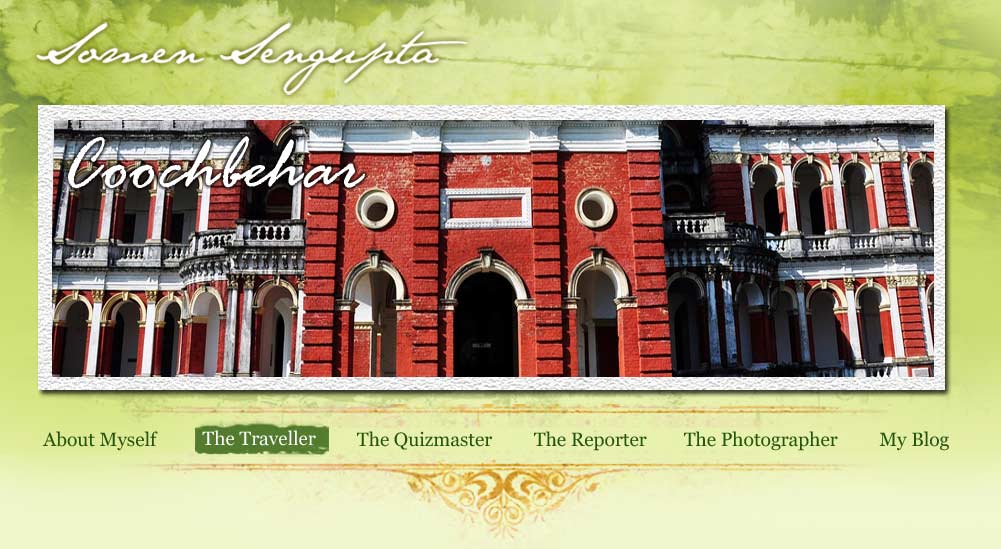Cooch Behar is one of the few places in Bengal that continued to flaunt a royal family during British rule. And it is the last vestiges of this grandeur that draws tourists to this small North Bengal town beside the Torsa river.
The historic and mythological associations coupled with its natural beauty makes Cooch Behar an ideal ‘‘short tour'' destination.
In the local language “Kock” simply means lap, but many glorify it as one of Lord Shiva's pet haunts. Ancient Tantric texts refer to this place as Kochbadhurup and elsewhere there is mention of it as the hiding place of some Khatriyas fleeing Parashuram's rage.
 The kingdom of Cooch Behar is said to have been established by Raja Bishwasingha Singh in 1510. His son Naranarayan expanded the kingdom from North Bengal to Assam and constructed the famous Kamakshay temple of Assam. Later of course the family adopted the Vaishnav faith and the Madanmohan temple was built in Cooch Behar. The 17th century saw many gory wars between Cooch Behar and the neighbouring kingdom of Bhutan. On 15 April 1773, a treaty with the East India company gave Cooch Behar the status of an independent princely state but in September 1949 the last king, Jagadeependranarayan, agreed to merge his state with India. The kingdom of Cooch Behar is said to have been established by Raja Bishwasingha Singh in 1510. His son Naranarayan expanded the kingdom from North Bengal to Assam and constructed the famous Kamakshay temple of Assam. Later of course the family adopted the Vaishnav faith and the Madanmohan temple was built in Cooch Behar. The 17th century saw many gory wars between Cooch Behar and the neighbouring kingdom of Bhutan. On 15 April 1773, a treaty with the East India company gave Cooch Behar the status of an independent princely state but in September 1949 the last king, Jagadeependranarayan, agreed to merge his state with India.
The main attraction of this town is the Palace - an exquisite example of European architecture. What we see today is not the original place (this was destroyed in 1812) but a new one built in 1879 by King Nripendranarayan. The well-known architect, Martin, and the Marlior & Edward company built the three storeyed paoace covering 51,309 square feet. With a central dome, arches and pillars, it greatly resembles St Peter's Church in Rome. The seven-year constructuion cost Rs 877, 203, but in 1897 an earthquake caused one of its floors to sink underground.
One can, however, still see the Durbar hall illuminated by 12 glass panels set into the roof. A balcony goes right round the dome at a hight of 124 feet.
On the marble floor is carved the royal ensign and the Sanskrit motto: Yathodharmo tathojay (Wherever religion is, is victory). The palace has 64 rooms once adorned with expensive carpets and artistic furniture. On the walls hang hunting trophics and priceless oil paintings by Indian and European masters. When the last king, Jagadeepnarayan Bhup Bahadur, died in 1973, the palace was looted and became a den for antisocials. In 1982 the Archeological Survey of India took over and renovated it into a museum. The palace is now beautifully illuminated very evening.
There are many beautiful lakes like the Sagardighi which hosts numerous migratory birds each winter. Beside it is a temple established by King Harendranarayan in 1807.
The royal temple of Madanmohan is another attraction. Built in 1889, this round structure also houses many other deities like Kattayani, Mongalchandi, Annapurna and Kli.
Every year in the month of Kartik (late November) the Rass Mela is organized in front of this temple. This is the oldest and biggest fair in Borth Bengal.
Cooch Behar buildings speak of an overwhelming European influence. There is Victoria College, now named Acharya Brajendra Seal College, Jemkins School, Kochbihar Club, Victoria Tower, Collector's Building and many more.
One should also visit the Devi Bari, the Durga temple and the Baneshwar temple. The last is unique in many ways, perhaps the only Shiva temple in India where animal sacrifice is a century-old tradition and non-vegetarian Prasad is offered to the god.
Situated on the Cooch Behar-Ali-purduar highway, the Baneshwar temple is just an hour's drive from Toofanganj town. King Prasannanarayan is said to have founded the temple some 500 years ago but according to mythology an Asura king, Banasur, was the original founder.
It is said that Usha, the daughter of King Banasur, was married to Anirudha, the grandson of Krishna. The marriage was however conducted without the consent of Banasur. In relation, Banasur held Anirudha captive in his palace. A furious war ensued between the armies of Krishna and Banasur. Since Banasur was a devotee of Shiva, Shiva was called to act as peacemaker. Banasur ultimately consented but once more conducted the marriage on this spot and built a Shiva temple.
The shape of the Baneshwar temple differs greatly from traditional Bengal school architecture. Instead of the ekchala or aatchala, this temple has a square structure with a small round top. It has only one gate with a garvagriha. A pond beside the temple hosts hundreds of giant tortoises which local people call Mohan. They are a sacred part of the temple.
Another place of interest is the famous Kamteshwari temple in Gosanimari, a few kilometers away. Established by King Prannarayan in 1665, the temple has ancient idols of Surya, Shiva, Narayan and Brahma. An ASI research project of 1952 established that a big fort once existed here and the place was once ruled by the Khens of the Kamtapur dynasty. Later on, in 1493, they were defeated by the Cooch Behar kings. A fair is organized here every April.
Access:
Overnight train from Kolkata to New Cooch Behar. Buses from Kolkata take 20 hours. You need to hire a car only to visit the Baneshwar and Kamteshwar temples. The rest are all centrally located.There are many good hotels and restaurants.
|



